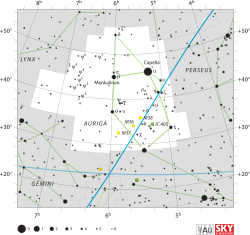Eta Aurigae
| Observation data Epoch J2000 Equinox J2000 |
|
|---|---|
| Constellation | Auriga |
| Right ascension | 05h 06m 30.89337s |
| Declination | +41° 14′ 04.1127″ |
| Apparent magnitude (V) | 3.18 |
| Characteristics | |
| Spectral type | B3 V |
| U−B color index | –0.66 |
| B−V color index | –0.18 |
| R−I color index | –0.17 |
| Astrometry | |
| Radial velocity (Rv) | +7.3 km/s |
| Proper motion (μ) |
RA: +31.45 mas/yr Dec.: –67.87 mas/yr |
| Parallax (π) | 13.40 ± 0.20mas |
| Distance | 243 ± 4 ly (75 ± 1 pc) |
| Details | |
| Mass | 5.4 ± 0.3 M☉ |
| Radius | 3.25 ± 0.18 R☉ |
| Luminosity | 955 L☉ |
| Surface gravity (log g) | 4.13 ± 0.04 cgs |
| Temperature | 17,201 ± 173 K |
| Rotational velocity (v sin i) | 95 km/s |
| Age | 22–55 Myr |
| Other designations | |
| Database references | |
| SIMBAD | data |
Eta Aurigae (η Aur, η Aurigae) is a star in the constellation Auriga. It has the traditional name Haedus II. With an apparent visual magnitude of 3.18, it is visible to the naked eye. Based upon parallax measurements made during the Hipparcos mission, this star is approximately 243 light-years (75 parsecs) distant from the Earth.
Eta Aurigae is a larger star than the Sun, with more than five times the Sun's mass and over three times the Sun's radius. The spectrum of this star matches a stellar classification of B3 V, which is a B-type main sequence star that is generating its energy through the nuclear fusion of hydrogen at its core. It is radiating 955 times the Sun's luminosity from its outer atmosphere at an effective temperature of 17,201 K. Based upon its projected rotational velocity of 95, it is spinning with a rotation period of only 1.8 days. Eta Aurigae is around 39 million years old.
Along with ζ Aurigae it represents one of the Kids of the she-goat Capella, from which it gets its Latin traditional name Hoedus II or Haedus II, from the Latin haedus "kid"; Zeta Aurigae is Haedus I. It has the less common traditional name Mahasim, from the Arabic المِعْصَم al-micşam "wrist" (of the charioteer), which it shares with Theta Aurigae. Since 1943, the spectrum of this star has served as one of the stable anchor points by which other stars are classified. It has an apparent visual magnitude of 3.18 and is located at a distance of around 243 light-years (75 parsecs) from Earth.
...
Wikipedia

